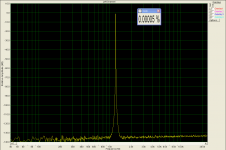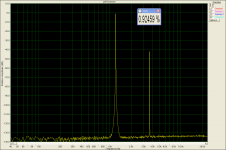Actually, words should do it.
Actually, there's a similar situation for vibrations (local + global, with the polynomials)
More transparent in a matrices outfit, if you don't mind the comment.
Actually, there's a similar situation for vibrations (local + global, with the polynomials)
More transparent in a matrices outfit, if you don't mind the comment.
Yes, a matrix is the best presentation, but when I paste one into this engine it does not come out that way. I suspect an attached file would be better.
SY,
The only Elmore & Sands I find is dated 1949, is that the one you refer to?
Yes there may be than one person who can follow the math. Now how many people on these threads KNOW how bad (Pick 1), local feedback, global feedback, no feedback, feed forward, etc. sound.
I will do the pictures in COLOR given the time just to get the point across!
ES
Now how many people on these threads KNOW how bad (Pick 1), local feedback, global feedback, no feedback, feed forward, etc. sound.
Shouldn't you add : and at which point in time ?

The only Elmore & Sands I find is dated 1949, is that the one you refer to?
Yes. I think the edition I have is later, maybe early 60s?
edit: I was mistaken- they looked at effects on noise and bandwidth, not harmonic distribution.
As far as 'Linear Audio' Vol. 1 is concerned: I have been reticent in commenting on it, because I might say something that is either just polite and complementary, or I might slip into some moderate criticisms, if pressed. Then the 'fur might fly' and this is what I hope to avoid.
I found Ed Simon's resistor article on Resistor measurement excellent and useful.
As to the rest of the articles, I am fairly aware of the design facts and processes, so there were not surprises there. Useful material for the newly exposed engineer or technician to these design approaches.
For the record, 'We put TIM and SID together as the SAME, back in the late 1970's, as I personally got Walt Jung and Matti Otala together to sort it out, when we were all at an AES convention together. Making any corrections to 'history' at this time appears to be because the writer was not even born when we were researching (in the wilderness, comparatively) and names and definitions were still vague. After we spent about 10 years separately and collectively, working on the problem, we had it pretty well down, as we explained to Bob Cordell in our follow up to his similar criticisms in 'Audio' back about 1980.
It is always easy, after the fact, to criticize the 'overstatements or oversights' of others, once the 'fog of discovery', clears.
I found Ed Simon's resistor article on Resistor measurement excellent and useful.
As to the rest of the articles, I am fairly aware of the design facts and processes, so there were not surprises there. Useful material for the newly exposed engineer or technician to these design approaches.
For the record, 'We put TIM and SID together as the SAME, back in the late 1970's, as I personally got Walt Jung and Matti Otala together to sort it out, when we were all at an AES convention together. Making any corrections to 'history' at this time appears to be because the writer was not even born when we were researching (in the wilderness, comparatively) and names and definitions were still vague. After we spent about 10 years separately and collectively, working on the problem, we had it pretty well down, as we explained to Bob Cordell in our follow up to his similar criticisms in 'Audio' back about 1980.
It is always easy, after the fact, to criticize the 'overstatements or oversights' of others, once the 'fog of discovery', clears.
But irrespective of his birthdate, do you have a substantive technical criticism of Bruno's article? Or do you agree with his analysis and conclusions?
Elmore & Sands
The Manhattan Hi(gh)-Fi(ve), right ?
Peter van Willenswaard was very much around, iirc.
Last edited:
Well shown, PMA, this is really interesting!
Yes. I hope it might be helpful even for you, regarding what issues to concentrate on.
Yes. I think the edition I have is later, maybe early 60s?
edit: I was mistaken- they looked at effects on noise and bandwidth, not harmonic distribution.
Which raises the issue of distortion types. In the math based example I used simple harmonic distortion although crossover notch did get mentioned.
For non-harmonic distortion any speculation on which is easier to do, measurements or math modeling?
Yes, PMA, it is helpful. Right now I am working on ultra low noise power supplies for phono stages. This is an interesting area of interference frequency that I have not looked at carefully enough.
For non-harmonic distortion any speculation on which is easier to do, measurements or math modeling?
Do you have MathCAD or the Wolfram package?
Do you have MathCAD or the Wolfram package?
I have MatLab. Currently on that front we are developing a true feedback eliminator. It is not a notch filter! I did write a small piece on how it works in Sound and Video contractor almost 20 years ago. But now it is a trade secret as to how much further we are in making it work well.
I haven't used MatLab, but with MathCAD or Wolfram Mathematica, it should be pretty easy to model. One or two benchtop experiments to confirm the accuracy of the model (or, if appropriate, verify any outre predictions), and you'd have a nice article.
I haven't used MatLab, but with MathCAD or Wolfram Mathematica, it should be pretty easy to model. One or two benchtop experiments to confirm the accuracy of the model (or, if appropriate, verify any outre predictions), and you'd have a nice article.
Math can do a decent model if everything is right. I have done a bit of that. Now reality gets a chance to rear its' head. I will build two non-linear amplifiers and measure them alone and in series both ways with and without global feedback.
Almost no one ever argues with actual measurements. Some one did once but it turns out they misread just about everything in the article. (See LA Vol. 1 Letters!)
I've had the same issue with my article in Vol 0. 😀
You mean somebody read Vol. 1! I know you have seen the work bench thread. I am surprised no one has replaced all those little plastic drawers with a foam notebook. I no longer use over 200 drawers and find parts much faster. My oversized ego told me that other folks would be copying that and presenting it as their own! Hasn't happened!
Charles Hansen spoke about audibility of different SW for playing wav files. Let's make our own test. The following files are generated in 96kHz/16 bit
http://web.telecom.cz/macura/1.2k.wav
http://web.telecom.cz/macura/1.2k_2H.wav
http://web.telecom.cz/macura/1.2k_3H.wav
http://web.telecom.cz/macura/1.2k_4H.wav
http://web.telecom.cz/macura/1.2k_5H.wav
They are extremely pure, as you can see from attached images. The 1st file is pure, the other files have 1% harmonic distortion by component seen in the file name. Try audibility of harmonic distortion and try different replay software.
http://web.telecom.cz/macura/1.2k.wav
http://web.telecom.cz/macura/1.2k_2H.wav
http://web.telecom.cz/macura/1.2k_3H.wav
http://web.telecom.cz/macura/1.2k_4H.wav
http://web.telecom.cz/macura/1.2k_5H.wav
They are extremely pure, as you can see from attached images. The 1st file is pure, the other files have 1% harmonic distortion by component seen in the file name. Try audibility of harmonic distortion and try different replay software.
Attachments
- Status
- Not open for further replies.
- Home
- Member Areas
- The Lounge
- John Curl's Blowtorch preamplifier part II

